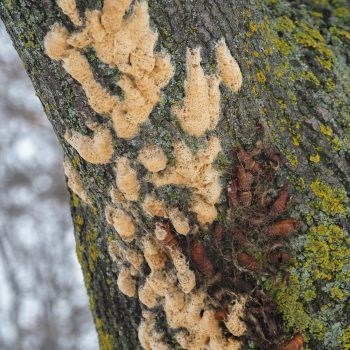Newmarket is moving into the next stage of its battle against the dreaded Lymantria dispar dispar (LDD) moth as they begin laying eggs throughout the community.
The invasive species has infested trees throughout the town and York Region, prompting municipal campaigns to give away burlap to trap their caterpillars. The municipality said tree leaves consumed by the caterpillars are starting to recover, but attention now turns to scraping off and destroying egg masses from trees as the insect moves into the pupa and moth stages throughout July and August.
Newmarket commissioner of development and infrastructure Peter Noehammer said the burlap program went fairly well and had good uptake from residents. But the region is bracing itself as it expects the population will continue to be high next year as well.
"There is still quite a large population of the LDD moth that is now evolving into the next stages of their growth," Noehammer said. "Monitoring that as it goes through next stages, so we're prepared for the fall and winter."
READ MORE: 'It's just the beginning' for invasive moth outbreak in Newmarket
The moths’ caterpillars are known to be harmful to vulnerable trees by consuming leaves. Municipalities across York Region have coordinated to address the problem, implementing burlap trap programs while avoiding the use of pesticides for environmental and financial reasons, according to Noehammer.
Municipalities are now watching as moths start to hatch from cocoons and lay hundreds of eggs on trees to start the cycle over again. Noehammer said the municipality will be surveying these eggs to track populations, while also making removal efforts.
LDD outbreaks can last multiple years, with York Region expecting another outbreak in 2022 based on 2019 and 2020 egg mass surveys. Noehammer said despite best efforts, the population is going to maintain itself next year, based on a 10-year cycle.
But he added there are signs of a recurring virus that will stem the population after that, which means there should not be a noticeable population for several years starting in 2023.
"The efforts we make are best efforts to try and reduce the population as much as possible," Noehammer said. "But the science behind it indicates these things, as I mentioned, come in cycles."
Newmarket Mayor John Taylor asked for a report on the LDD moths at a July 19 meeting, including what the municipality has done to address them, and future planning. The report will come back to council in the fall.
“Certainly, it’s been impactful in the community. I think we’ve shared a lot of great information with the community about what makes sense and what doesn’t,” Taylor said. “We’ll have more questions arise.”
Burlap trapping is finishing, though residents can save their burlap to trap caterpillars next year. Now, you can continue to help by scraping off any egg masses that you see on your trees in the months to come, putting them into soapy water, according to the Newmarket website.
Noehammer said the town's web page will be updated to include more information about addressing egg masses in the coming weeks.
"Thank (you to) the community for doing their part in trying to get through the evolution of this LDD moth population," he said.


